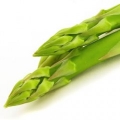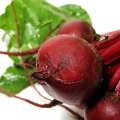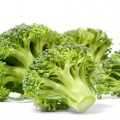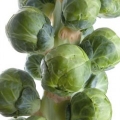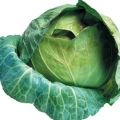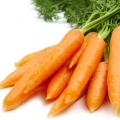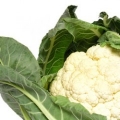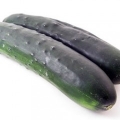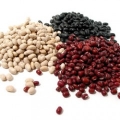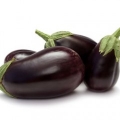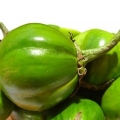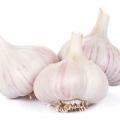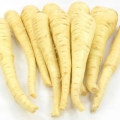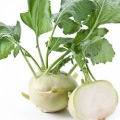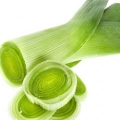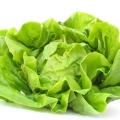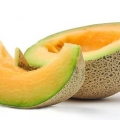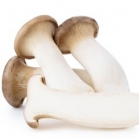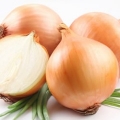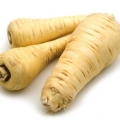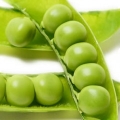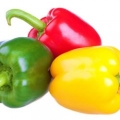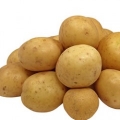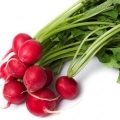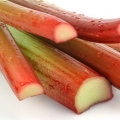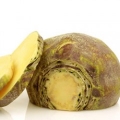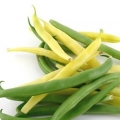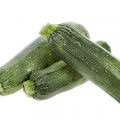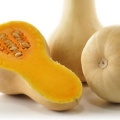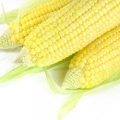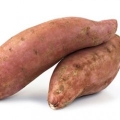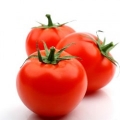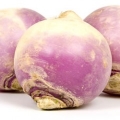Crops
Asparagus
view all Asparagus related contentAsparagus is a popular early-season vegetable. There are approximately 200 acres grown on 129 New York farms annually (2007 Census of Ag). The majority is sold for fresh-market, but a small amount (18 acres) goes for processing. Asparagus is available from the beginning of May through mid-June in New York. It is a popular vegetable at farmer's markets, U-pick operations, retail stands and is also grown for wholesale markets.
Commercial asparagus fields are generally planted with one-year old crowns; however, transplants can also be used. Fields take two years to establish, but afterwards can remain in production for 10 to 20 years.
Beets
view all Beets related contentDid you know that New York is the second leading producer of red table beets in the US? Approximately 3,000 acres are grown annually for processing by Seneca Foods in Leiceister, NY (Livingston Co.). Most of the processing beets are grown in Genesee, Livingston and Wyoming Counties in Western, NY. Processors require specific varieties for production of certain size roots throughout the season and commonly grow Ruby Queen, Red Ace and Red Atlas.
Fresh market growers have a wide range of varieties to select from. Root colors include red, golden, or alternating red and white rings. Roots may be cylindrical or elongated. Beets can be harvested for fresh market at any stage and the greens are considered a delicacy by some. Roots harvested in the fall can be stored and sold at winter markets.
Educational and research information from Cornell Cooperative Extension can be found by clicking on the links below.
Broccoli
view all Broccoli related contentBroccoli is grown on an estimated 800 acres throughout New York State. Multiple plantings are typically grown along with other Cole crops such as cauliflower, cabbage and kale on small-scale diversified vegetable farms. Broccoli is predominantly grown from transplants set in April and May for a spring crop and in late June through August for a fall crop. Broccoli that is harvested in July and early August tends to have very high cull rates due to abnormalities caused by heat stress. Broccoli is cut during the cooler part of the day and sold as soon after harvest as possible, as it does not store well.
Fortunately, recent genetic breakthroughs have overcome broccoli's susceptibility to heat stress and broccoli growers in New York look forward to the availability of new varieties adapted to the hot and humid summers of the Northeastern United States. Cornell University is leading an ambitious effort to develop a $100 million broccoli industry in the Eastern United States. Below you will find educational information and results of our research trials.
Brussels Sprouts
view all Brussels Sprouts related contentBrussels sprouts are grown on roughly 88 farms in New York, with 58 acres harvested for fresh production and 2 acres for processing (2007 Ag Census). They are members of the Brassicaceae family which includes cabbage, cauliflower and broccoli. Being cool season crops, they are well suited to the New York climate. Most cruciferous crops have similar cultural requirements and are susceptible to a common set of insects and diseases.
Seeds of Brussels sprouts are typically sown in a greenhouse or seed bed about 5-6 weeks prior to transplanting into the field beginning around mid-June. Fields are ready for harvest between 90 to 180 days after planting, depending on the variety and weather conditions. In New York, harvest occurs from September through November.
Buds or sprouts grow along the sides of long, thick stalks and mature from the base of the plant upwards. They are harvested when they are 1 to 2 inches in diameter. Individual buds may be hand harvested into baskets, with several harvests per season. Alternatively, entire stalks can be harvested and sold for processing or at the retail market.
Cabbage
view all Cabbage related contentFertile soils and favorable climate contribute to the impressive production of cabbage in New York State. With more than 12,000 acres grown annually, New York ranks in the top three states nationally for both fresh market and kraut cabbage. Fresh cabbage is sold in retail and wholesale markets and is used for cole slaw, egg rolls and other products. Under the proper conditions, cabbage can be stored through April, making it available nearly year round. There are two large processors in Western, NY (Seneca Foods and Great Lakes Kraut). Kraut cabbage is harvested late in the fall. It is trimmed, shredded, mixed with salt and then fermented in huge vats. The product is then packed in cans, glass jars or sealed plastic bags.
Many varieties are available for fresh market, storage and kraut cabbage. Varieties also differ in their susceptibility to insects and diseases. Cornell Cooperative Extension Educators and Cornell faculty work together annually to conduct research on many aspects of cabbage production in the state. Below you will find educational information and results of our research trials.
Carrots
view all Carrots related contentCarrots are a popular and versatile vegetable grown on many farms in New York. Fresh market growers have a wide range of varieties available for production intended for farm stands, farmer's markets, school lunch programs and wholesale markets. Fresh market carrots also come in a rainbow of colors. Roughly 2,000 acres of carrots are grown in Western, NY for the processing market. Blunt-tipped Nantes varieties are preferred for sliced, processed products and blocky Chantenay or Danvers types are used for dicing.
Obtaining long, straight, smooth roots can be difficult. The best soils are light-textured with few stones or well-drained muck. Good soil health is also important as excess moisture and/or compaction will limit root growth and quality. Insects, diseases and nematodes can also injure carrot roots.
Cauliflower
view all Cauliflower related contentAbout 500 acres of cauliflower are planted in New York annually. Cauliflower is a member of the Brassicaceae family which includes cabbage, broccoli and Brussels sprouts. All of these crops do well in the climate of New York, but cauliflower is produced as a fall crop to avoid summer heat which can cause heads to become soft and over-mature quickly. Heads maturing in hot weather (over 80 degrees F) can exhibit riciness, leafy heads, off color, loose heads or poor wrapper leaf development. Cauliflower is typically harvested from August through November in New York. Most cruciferous crops have similar cultural requirements and are susceptible to a common set of insects and diseases.
Recently, orange and purple varieties are becoming more common along with the traditional white forms.
Cucumbers
view all Cucumbers related contentIn 2014 there were approximately 1,800 acres of cucumbers grown in New York worth $10.1 million (2014 Vegetable Summary). The majority of this production is for fresh consumption, including small scale retail operations, as well as wholesale production to serve larger markets throughout the Northeast U.S. In addition to open field production cucumbers are increasingly grown inside greenhouses and high tunnels. The crop, when unhindered by pests and diseases, can provide high yields within a short harvest window. Cucumber production in New York is increasingly under threat from the foliar disease Downy Mildew (Pseudoperonospora cubensis). Thus the Cornell Vegetable Program is collaborating with partners to conduct advanced on-farm research to enhance production and marketing of cucumbers, including the development of improved varieties suited for organic agriculture. Stay tuned for more information on this project. In the meantime check out results from our variety trials and grafting work with cucumbers below.
Dry Beans
view all Dry Beans related contentDry edible beans are grown almost exclusively in Western NY (such as Genesee, Livingston, Monroe and Wyoming counties) and in Central NY (such as Ontario, Yates, Seneca and Cayuga counties), where soils are deep, fertile and light- to medium-textured. New York produces edible dry beans on up to 16,000 acres for local, regional (east of the Mississippi), export and organic markets. Those beans marketed regionally are either processed into canned product or packaged for the dry pack market. Value of the crop in the state varies but has averaged around $7 million/year recently.
Major types include varieties of black turtle soup and light/dark red kidney beans. Adoption of reduced, zone tillage has been occurring on a number of farms as a time and fuel-savings measure. Insect, disease and weed pests are similar to those seen on snap beans and are managed similarly. Because dry beans must mature on the plant they are out in the field much longer than snap beans, however, so there is more opportunity for diseases such as white mold to develop. Weeds must also be controlled for a much longer period.
Eggplant
view all Eggplant related contentEggplant is a commonly grown fresh market crop in New York, particularly for direct-sales such as farm stands, CSAs and farmers markets. In 2010 there were 400 acres of eggplant in the state with a value of over $4 million (2011 Vegetable Summary). Eggplants yield best in New York when grown on black plastic mulch with drip irrigation. The Cornell Vegetable Program scouts eggplant weekly in the growing season to provide pest and disease updates via VegEdge, our grower-oriented newsletter. Research projects from our program that address eggplant include grafting and specialty variety trials. Check out our links below!
Ethnic Vegetables
view all Ethnic Vegetables related contentProduction of ethnic vegetables is a growing trend on many New York farms. A large assortment of exotic vegetable types while unfamiliar to many Americans may be a taste of home to foreign nationals, immigrants and ethnically-based communities. Most of these ethnic vegetables can be successfully grown in New York. The key to marketing is to select varieties that are familiar to the consumer group. Many immigrants are excited to be able to purchase fresh produce grown locally that would be readily available in their country of origin. Producing ethnic vegetables can be rewarding, but should be properly researched and tried on a small scale to begin.
Garlic
view all Garlic related contentGarlic production has increased significantly in New York over the last few decades, and garlic is now considered to be an important niche crop. In 1992, only 11 acres of garlic were reported in New York, but by 1997 the number grew to 153 acres and by 2007 it again doubled to 306 acres. Garlic is currently estimated to be a $20 million dollar crop. New York is the fifth largest garlic producing state in the country, and ten percent of all New York vegetable farms report growing garlic. That is a higher percentage of growers than for broccoli, cabbage, carrots, lettuce, or onions.
Garlic is sold at farmers' markets from mid-summer to the fall throughout the state. Garlic is also sold at festivals which take place throughout the Northeast from August through October. New York's largest festival is in Saugerties, in September. Festivals are important outlets for growers and important agrotourism events for the cities that host them.
Varieties of garlic grown in New York tend to be different from those you will find in the grocery store. New York is known for excellent 'hardneck' garlic, which has a hard stalk running through the center of the bulb. The flavor of our hardneck garlic is often considered to be stronger and more unique than the flavor of 'softneck' varieties found in the grocery store and grown primarily on the West Coast or in China.
Horseradish
view all Horseradish related contentHorseradish is a minor crop in New York, with 5 acres produced on 8 farms (2007 Ag Census). Some of the smaller acreage is probably not reported. It is a member of the Brassicaceae or cabbage family which makes it related to turnips. The greens are edible and may be available at farmers markets in the spring/summer. However, the pungent root is generally what is cultivated and sold. Roots are generally harvested in the fall. They store well and are available throughout the winter.
Kohlrabi
view all Kohlrabi related contentKohlrabi is a minor crop in New York, but is popular at farmers markets and other retail stands. Its mild flavor makes it favorable to eating fresh and even young children like it when cut up and served like carrot or celery sticks. Both green and purple varieties are available. It is best grown in cooler temperatures and is typically available in June and July and then again in September and October. Kohlrabi is a member of the Brassicaceae or cabbage family which also includes broccoli, cauliflower and turnips. It can be susceptible to many of the same diseases and insects as other members of this family.
Leeks
view all Leeks related contentThere are roughly 30 acres of leeks grown in New York annually. They are an edible member of the Liliaceae or lily family. They are tender and have a mild onion flavor with a slightly sweet edge. Leeks may be planted in late February to March for harvest in early- to mid-summer. Alternatively, they may be planted in July for harvest in late fall/early winter.
Leek is an expensive crop to grow, because it is labor intensive. Hand labor is required for all stages of production including: transplanting, weeding, harvesting, washing and packing.
Information on cultural practices and pests of leeks can be found in the Leek Pest Management Strategic Plan.
Lettuce / Leafy Greens
view all Lettuce / Leafy Greens related contentTwo dozen or more types of leafy greens are grown in New York, primarily for fresh market production. According to the 2007 Census of Agriculture, 224 New York farms produced 1,398 acres of lettuce. Leaf lettuce is the most widely grown with 758 acres, followed by 381 acres of head lettuce and 260 acres of romaine lettuce. Lettuce is grown for local sales as well as large wholesale markets in the Northeastern, US.
Other popular greens are spinach (247 acres), collards (96 acres), escarole & endive (75 acres), kale (57 acres), mustard greens (36 acres) and turnip greens (16 acres). Additional types for which no statistical information is available include: arugula, beet greens, bok choy, dandelion greens, radiccho, rapini, swiss chard and watercress.
Field-grown greens are available beginning from May through mid-October (depending on the type). However, the season can be extended by growing in tunnels protected from harsh winter temperatures.
Melons
view all Melons related contentFresh market production of melons has been an important crop for NYS growers for many years. Cantaloupe are predominantly the main type of melons grown, but Honeydew, Crenshaw, Watermelon and Gallia types can also be grown quite nicely in our climate. Recently, "personal" or "ice box" types of melons, which have been bred for individual consumer use are much smaller (2-3 pounds) and have become favorites of consumers at roadside stands and farmers markets. Nearly all the melons grown in NY are produced on raised beds mulched with black plastic and drip irrigation. Fusarium wilt, Powdery and Downy Mildew and Gummy Stem Blight remain the main disease issues with these crops. Striped Cucumber Beetles and aphids remain the major insect pests.
Mushrooms
view all Mushrooms related contentMushrooms are estimated to be grown on 85 farms throughout the state with a value of $4.3 million each year. New York State ranks tenth in the country for mushroom production (2022 Census of Ag).
Many types of mushrooms can be grown. Most mushrooms grown in our region of New York are Shiitake or Oysters, both considered "specialty mushrooms" by the USDA. These mushrooms are grown in a variety of outdoor, indoor, and hybrid systems including on logs, in the ground, in raised beds, or in blocks contained in buckets or plastic bags. Crops are sold fresh, dry, powdered, or incorporated into value-added products.
Onions
view all Onions related contentOnions are one of the most important vegetable crops in New York State with annual sales of approximately $52 million. New York accounts for 97% of the onion production in the North Eastern United States and ranks sixth in the nation. Approximately 12,000 acres of yellow pungent cooking onions are grown from direct seed, predominantly on organically rich muck soils. This crop is stored and marketed until April. Sweet and red varieties are also grown, mostly from transplants. Hundreds of small-scale diversified farms grow onions intensively on plastic beds on less than an acre. These onions can grow very large and be lucrative in the market place where they are sold through produce auctions, farmer's markets, roadside stands and CSAs.
Continued intensive production of onions in New York has led to an array of perennial pest challenges, as well as the introduction of new pests, so that management of the onion complex in New York requires a very strategic research-based approach. Cornell Cooperative Educators and Cornell faculty work together to conduct research on many aspects of onion production in the state. Below you will find educational information and results of our research trials.
Parsnips
view all Parsnips related contentParsnips are a minor crop in New York, but can be found at farmer's markets and retail stands. They are harvested in April and May or from October through December. Parsnips can be stored over the winter and are a good crop for winter farmers markets. Parsnips are a member of the Apiaceae or carrot family. They are grown much the same way as are carrots and are susceptible to many of the same diseases and insects. Like carrots they require a deep, well-drained soil. They can be grown on either mineral or muck soils.
A good summary of parsnip production can be found at the Ontario Ministry of Agriculture, Food and Rural Affairs website.
Peas
view all Peas related contentPeas are one of the first crops planted and harvested in New York. Fresh market, edible pod and processing peas are all produced. In fact, the state has a long history of processed pea production with a 10-year average of 17,689 acres grown. Processed peas are grown in fields ranging in size from 20 to 100 acres. Processors select the varieties to ensure consistent supply to the plants. The peas are machine harvested and shelled right in the field and taken to the plant for sorting, cleaning, freezing and packaging.
Fresh edible pod peas or podded peas which are shelled by the consumer are a delight in early season markets. These markets are more concerned with blemishes on the pods.
Peas are very sensitive to excess soil moisture and are susceptible to numerous soil pathogens. Weeds can quickly out-compete peas and are a special problem in late-April and May plantings when temperatures are favorable to annual weed seed germination.
Cornell Cooperative Extension Educators and Cornell faculty work together annually to conduct research on many aspects of pea production in the state. Below you will find educational information and results of our research trials.
Peppers
view all Peppers related contentBell, or sweet, peppers are an important crop on New York fresh market vegetable farms, worth in aggregate close to $10 million according to the most recent data (2011 Vegetable Summary). Hot peppers, such as jalapenos and habaneros, can be important specialty items for direct sales. Peppers are grown in commercial fields with floating row covers, plastic mulch and drip irrigation. For colored peppers early maturing varieties are a good choice for NY growers. Resistance to the soil-borne pathogen Phytothphora capsici is another important attribute. Greenhouse and high tunnel production of peppers is on the rise among CSA, produce auction and market farmers. The Cornell Vegetable Program conducts a number of research projects on peppers such as variety trials and organic fertility.
Potatoes
view all Potatoes related contentPotatoes are grown all across NYS, though the largest farms tend to be located in Western NY, the Finger Lakes Region and on Long Island, on deep, fertile, light- to medium-textured mineral soils, and on muck (organic) soils. Potatoes are grown on small, medium and large farms, for retail, wholesale (east of the Mississippi) and organic markets, for both fresh market and processing into chips, and for certified seed potatoes. Most growers store some of their crop for winter sales. Varieties include round whites, red-skinned potatoes, yellows, and a smaller acreage of a wide variety of specialty types, such as those with blue or red skin and flesh, fingerlings, etc. Potatoes are one of the highest value vegetables in NY, grown on 16,000 acres, with an average value of about $54.9 million recently (2014 Vegetable Summary).
Potatoes have many serious insect and disease pests. Late blight can be a devastating disease, capable of completely destroying an unprotected crop within 3 weeks in wet weather, and rotting the tubers. Late blight was the major cause of the Irish Potato Famine. It also affects tomatoes. New, more virulent strains of late blight fungus began showing up 20 years ago and the disease has been harder to predict and control ever since. Early blight is a common fungal disease on both potatoes and tomatoes which survives over-winter in the soil. Colorado potato beetles can cause serious defoliation if crops are not rotated up to a quarter mile from where they, tomatoes or eggplant were previously planted. They can rapidly become resistant to commonly used insecticides. Tiny, sucking leafhoppers move up from the south each June on weather systems, and can cause severe leaf burn and yield reduction. Aphids can also be a production problem as well as carrying viral diseases that can affect potatoes grown from saved seed.
Pumpkins / Gourds
view all Pumpkins / Gourds related contentNew York State ranks among the top 3 states (Illinois and Pennsylvania are the other two) in pumpkin production in the country with over 5,500 acres of production with an estimated value of $20.5 million each year (2014 Vegetable Summary). Nearly all of these are for fresh market use for either decorating or eating. The pumpkin industry is highly variable with fruit ranging from quarter pound to several hundred pounds each. Pumpkins are grown throughout NYS and are marketed through roadside stands, nursery centers and farmers markets and are also important in areas that have lots of agri-tourism. Included in this group are also other fall ornamentals such as gourds and ornamental squash. Pumpkins are susceptible to many different diseases, the most prevalent of those being Powdery Mildew, Downey Mildew and Phytopthroa blight. In the last eight years, plant breeders and seed companies have released a multitude of varieties resistant to Powdery Mildew and are widely used by growers. Another concern for growers are several different viruses which can cause plants to not produce fruit at all or results in poor fruit quality (size, color etc.). Striped Cucumber Beetles and Squash bugs remain the main insect pests. Aphids are also important because they are the primary vectors of those viruses mentioned above.
Radishes
view all Radishes related contentApproximately 154 acres are produced on 57 farms (2007 Census of Ag) in New York. They are harvested from May through September.
Radishes come in many shapes, sizes and colors. Small round types are popular for salads. Radishes with long roots, including daikon varieties are a popular ethnic vegetable that can be eaten fresh or cooked in a variety of ways.
Rhubarb
view all Rhubarb related contentA minor crop in New York, 24 acres of rhubarb are grown on 57 farms in New York (2007 Census of Agriculture). Rhubarb is a perennial crop which grows well in the cool climate of New York. Growth begins when temperatures warm in the spring. The typical harvest season is May through July. Rhubarb plantings can remain productive for eight or more years. Rhubarb is relatively free of insect and disease problems, but perennial weeds can become problematic.
Rutabaga
view all Rutabaga related contentA minor crop in New York, rutabaga can sometimes be found in farmers markets or retail stands. It is harvested from August through November. Rutabaga is thought to have originated from a cross between a turnip and cabbage. All cruciferous crops share a common set of diseases and insects. Rutabaga is grown in much the same way as turnips.
Snap Beans
view all Snap Beans related contentSnap beans are grown on a variety of farms throughout New York State. They are sold at roadside stands and other retail markets, wholesale markets and for processing. Snap beans come in many varieties to meet the needs of various markets and growers should consult seed suppliers and markets to select appropriate varieties. New York typically ranks 2nd or 3rd in the nation for processing snap bean production with 20,610 acres grown in 2014 (2014 Vegetable Summary). Similarly, the production of nearly 10,200 acres of fresh market beans consistently places New York in the top five producing states.
All snap beans share a general group of insects, diseases and abiotic disorders. While weed control strategies may vary with farm type and size of plantings, herbicides labeled for production are consistent for all types. Cornell Cooperative Extension Educators and Cornell faculty work together annually to conduct research on many aspects of snap bean production in the state. Below you will find educational information and results of our research trials.
Squash - Summer
view all Squash - Summer related contentNew York State has a strong industry growing winter and summer squash with over 5,000 acres produced in 2011 with a value of over 43 million dollars. A lot of summer squash is sold on the wholesale market, but nearly all of it is consumed fresh. Zucchini and Summer /Yellow squash are dominant types of summer squash grown in the area. Powdery and Downy Mildew, and Phytopthroa blight are the major diseases we are concerned with. Viruses are of major importance for summer squash growers and have led to plant breeders and seed companies to develop and release many different virus resistant varieties.
Squash- Winter
view all Squash- Winter related contentNew York State has a strong industry growing winter and summer squash with over 4,000 acres produced in 2014 with a value of over 31 million dollars. There are many different types of winter squash that are grown including hubbard, buttercup and spaghetti, but butternut and acorn types are the two dominant ones for production. Winter squash is also sold for wholesale and fresh market use. There is also a significant amount of butternut squash that is cut and peeled and repacked and sold through grocery stores. Powdery and Downy Mildew, and Phytopthroa blight are the major diseases we are concerned with.
Sweet Corn
view all Sweet Corn related contentSweet corn is popular with consumers and growers alike. In 2020, there were 27,000 planted acres in New York, with a farm gate value of $36.9 million (NY Ag Statistics).
A range of varieties are available to cover the growing season and needs of each market. Fresh market corn may be planted in March under plastic or later on bare ground. Planting of processing sweet corn in New York begins around May 1st with varieties selected to maintain a steady supply into mid-September.
Cornell Cooperative Extension Educators and Cornell faculty work together annually to conduct research on many aspects of sweet corn production in the state. Below you will find educational information and results of our research trials.
Sweet Potatoes
view all Sweet Potatoes related contentAlthough sweet potatoes have been grown in New York, they have received much more attention in the last couple of years due to the value of the health benefits it offers. Even though acreage is not normally recorded, we estimate that there are over 200 acres of sweet potatoes being grown throughout NYS. However, due to the long growing season that is required (100 days plus), they are generally produced on raised beds mulched with black plastic. Orange skinned, orange fleshed types are the dominant types grown here, but there are also white skinned, white fleshed and orange skinned, white fleshed varieties grown in the state. Sweet potatoes have also gained popularity with organic producers to replace winter squash production due to the fact that they have almost no disease or insect problems when grown here and can be stored longer then winter squash in many cases. The increase in winter farmer's markets or winter CSA shares has also increased sweet potato production in NY. However, deer and mice can be major vertebrate pests of sweet potatoes. Variety trials, plant density research and the use of floating rowcovers for increased production are being evaluated in the Capital District region of NY.
Tomatoes
view all Tomatoes related contentIn 2014 Empire State farmers planted 2,800 acres of tomatoes for an estimated value of $24.0 million (2014 Vegetable Summary). Most field production is devoted to determinate cultivars, with plastic mulch, drip irrigation and stake-and-weave trellis essential production elements for early and quality yields. Greenhouse (and high tunnel) production is on the rise in New York with structures of less than 1/10th to in-excess of 40 acres under protection. Indeterminate, greenhouse lines, as well as heirloom varieties are grown under protected culture. Tomatoes are a popular crop with New York fresh market vegetable farmers due to high demand and fair prices. The Cornell Vegetable Program conducts a number of research projects each year addressing improved tomato production. Check out the links below to learn more.
Turnips
view all Turnips related contentRoughly 172 acres of turnips are produced on 50 farms in New York (2012 Census of Agriculture). Turnips are in the Brassicaceae or cabbage family, which includes radishes. Seeds are planted in the spring or early summer for harvest from May through November. Turnips store well over the winter and are a good crop for winter farmers markets.

Upcoming Events
Genesee Valley Winter Produce Meeting --> CANCELLED DUE TO WEATHER
January 20, 2026
Farmersville, NY
Fresh market production meeting for small to mid-sized farms. Topics include: fundamentals of plant disease management, keeping yourself safe while spraying (organic & conventional), mushrooms, white mold management, selling at auction, and soil health.
Chautauqua Region Winter Vegetable Meeting
January 30, 2026
Randolph, NY
Fresh market production meeting for small to mid-sized farms. Topics include: vegetable disease management, keeping yourself safe while spraying (organic & conventional), soil and water sampling, managing soil organic matter, grower panel, industry and programmatic updates.
DEC credits available: 1.0 in CORE plus 1.5 in 1a and 23.
Eden Area Winter Vegetable Meeting
February 4, 2026
North Collins, NY
Join us for a mix of industry updates, crop protection talks, pesticide safety programming, and fertility management discussions. This meeting is jointly hosted by the Cornell Vegetable Program and Timac Laing-Gro.
1.25 DEC credits available in CORE plus 1.75 in 1a and 23.

